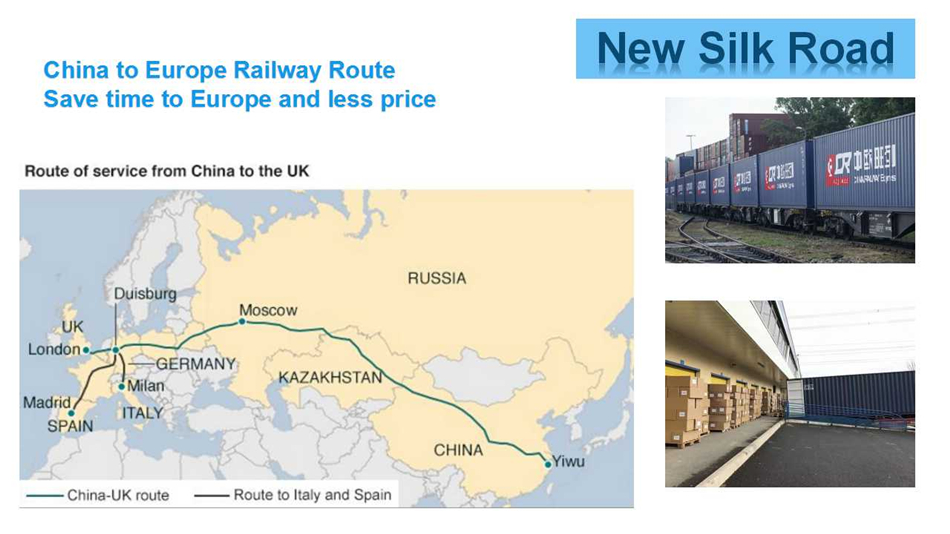Rail route to Europe improves freight transport
- Author:Anna
- Source:www.usa.chinadaily.com.cn
- Release Date:2018-01-15
With shorter transport times and lower costs for freight, international rail lines linking central and western China with Central Asia have helped to improve connectivity and trade between the regions.
Starting in Chongqing, the Chongqing-Xinjiang-Europe International Railway passes through Xi'an, Lanzhou, Urumqi and the Alataw Pass, where it enters Kazakhstan, before continuing through Russia, Belarus and Poland, finally ending in Duisburg, Germany.
Stretching 11,179 kilometers, it takes just 16 days on average to transport goods from China to Europe by rail, 20 days fewer than by sea from China's eastern ports, making rail ideal for goods with a shorter shelf life.
The cost is one-fifth that of transporting cargo by air, and there is just one customs inspection along the whole route between Chongqing and Central Asia. Since it began operating in 2011, the cost of transporting goods on the line has also fallen, from 80 cents per 22 metric tons of cargo for every kilometer, to 70 cents.
Goods transported along the route include electronics, cars, and medical equipment.
It has been compared with the second Eurasian Continental Bridge, a train line that starts at Lianyungang in East China's Jiangsu province and passes through the Alataw Pass in Xinjiang before ending at Rotterdam in the Netherlands.
The Chongqing-Xinjiang-Europe line has provided a boost to Chongqing's economy. According to Yuxinou Logistics, which provides logistics services along the railway, from January to May this year, freight transported out of Chongqing rose 5.9 percent, and freight into the city rose 8.3 percent.
The line links South China's manufacturing hub and Southwest China's industrial belt with European markets. Along the route into Europe is Nizhny Novgorod, a major transportation and distribution hub in Russia.
With the rapid development of Sino-Russian economic and trade relations in recent years, an increasing range of Chinese goods have been distributed through Nizhny Novgorod Railway Station, with an average annual growth of 8 percent.
Of the 2,627 containers that passed through the station in the first half of this year, 846 came from China, carrying building materials, cars, groceries and chemical products.

Starting in Chongqing, the Chongqing-Xinjiang-Europe International Railway passes through Xi'an, Lanzhou, Urumqi and the Alataw Pass, where it enters Kazakhstan, before continuing through Russia, Belarus and Poland, finally ending in Duisburg, Germany.
Stretching 11,179 kilometers, it takes just 16 days on average to transport goods from China to Europe by rail, 20 days fewer than by sea from China's eastern ports, making rail ideal for goods with a shorter shelf life.
The cost is one-fifth that of transporting cargo by air, and there is just one customs inspection along the whole route between Chongqing and Central Asia. Since it began operating in 2011, the cost of transporting goods on the line has also fallen, from 80 cents per 22 metric tons of cargo for every kilometer, to 70 cents.
Goods transported along the route include electronics, cars, and medical equipment.
It has been compared with the second Eurasian Continental Bridge, a train line that starts at Lianyungang in East China's Jiangsu province and passes through the Alataw Pass in Xinjiang before ending at Rotterdam in the Netherlands.
The Chongqing-Xinjiang-Europe line has provided a boost to Chongqing's economy. According to Yuxinou Logistics, which provides logistics services along the railway, from January to May this year, freight transported out of Chongqing rose 5.9 percent, and freight into the city rose 8.3 percent.
The line links South China's manufacturing hub and Southwest China's industrial belt with European markets. Along the route into Europe is Nizhny Novgorod, a major transportation and distribution hub in Russia.
With the rapid development of Sino-Russian economic and trade relations in recent years, an increasing range of Chinese goods have been distributed through Nizhny Novgorod Railway Station, with an average annual growth of 8 percent.
Of the 2,627 containers that passed through the station in the first half of this year, 846 came from China, carrying building materials, cars, groceries and chemical products.
